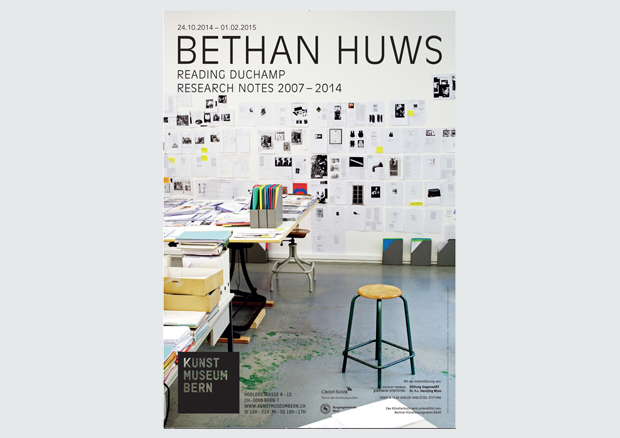Bethan Huws: Reading Duchamp, Research Notes 2007–2014, 24.10.2014 – 01.02.2015
Immerse Yourself in Bethan Huws’s Research Laboratory
Since the mid-1990s, the Welsh artist Bethan Huws (*1961) has explored the work of Marcel Duchamp (1887–1968), the spiritual and intellectual father of conceptual art, and, since 2007, has put together the findings of her research in works and sketches. These Research Notes will be shown at the Kunstmuseum Bern for the very first time in an installation filling a whole room.
Just like Duchamp, Huws delights in puns, ideogrammes and symbols. Much of Duchamp’s work, his Ready-mades and installations, with titles rich with allusion, is still an arcanum for us today, enticing Huws to puzzle and decode its hidden references.
Mind Map Spread over a
Room
Huws’s research notes consist of drawings, writings, collages,
postcards, photocopies from dictionaries and reproductions of Duchamp’s works. They
are being presented for the very first time in their entirety as an
installation, which is conceived as a room-filling mind map. The artist
conceived the installation, which virtually restages the situation of her
studio in Berlin when she presented her first research results to an art
historian. The research notes in the exhibition can be subdivided into two
categories. The “general files” are presented on tables in the exhibition and
contain insights into the general categories that Bethan Huws discerned within
Marchel Duchamp’s oeuvre, such as colour, geometry, numbers, painting, chess,
Christianity, myths, intellect, or the poet and art critic Guillaume Apollinaire, to name just a few. Huws
collected all the information related to the emergence of the subjects treated
in Duchamp’s work, viewing it in a specific context, in order to comprehend how
it fitted into Duchamp’s system on the whole. On the other hand, in the
“individual works” Huws examines Duchamp’s works by one by one, among them
famous pieces like Nude Descending a
Staircase (1912), the large work on glass Bride Stripped Bare by Her Bachelors, even (1915–23), or the installation Etant Donnés (Given, 1946–66). In order to decode the multilayered references
step by step, she places them in the greater context of Duchamp's oeuvre and within
French culture overall.
Intellectual Siblings
One of the many ties Huws and Duchamp share is that they both believed
that an artwork was the product of thinking about what makes art art. It is
only through interpreting or understanding an artwork that makes it art. Hence, Huws not only
seeks to interpret Duchamp’s work, but strives, at the same time, to show how
art produces meaning. Huws intellectually pursues the paths Duchamp himself
followed and probes his work by means of his own methods and strategies. In
contrast to an academic, art-historical study of her predecessor’s work, Huws
dares to not fill all the gaps in her research, allowing her subjective
interests to shine through and provides scope to draw conclusions about her own
work. Her comprehensive
study of this epochal artist, together with the insights she has won in this
way, provide an unconventional contribution to the art history of modernism and
the present. She thus creates
a profoundly sensitive and intelligent, independent artwork of her own, full of
humor and highly poetic, contemplating the fundamentals of art.
An Exceptional
Conceptual Artist
Bethan Huws was born in 1961 in Bangor, Wales. She studied at Middlesex Polytechnic (1981–1985)
and the Royal College of Art (1986–1988) in London. She lives and works in Paris and Berlin. Especially her Word Vitrines, her Ready-mades and
objects, and not to forget her videos, brought her international fame. Since 1999, the
Kunstmuseum Bern has been expanding its collection with works by this
exceptional concept artist.
Contact person: Brigit Bucher, , Tel.: +41 31 328 09 21
Images: Marie Louise Suter, , Tel.: +41 31 328 09 53


